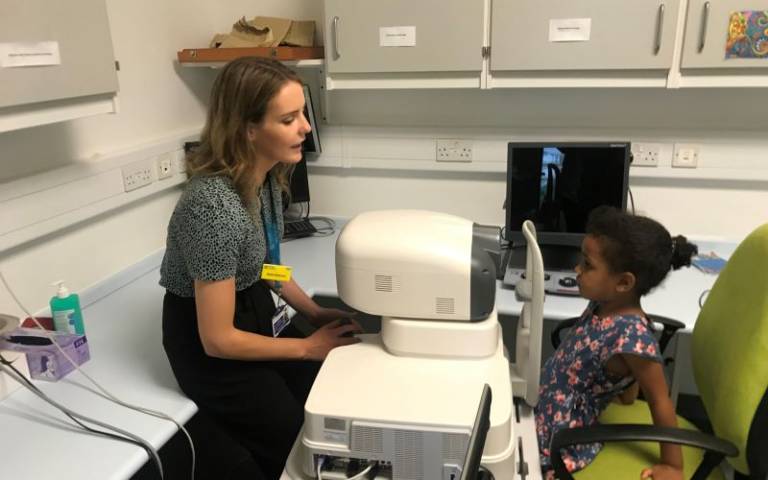Public needed to analyse images of blinding eye disorder
23 May 2022
Members of the public are being asked to examine and evaluate high-resolution images of the potentially blinding eye condition, uveitis, as part of a UCL-led project aimed at ensuring children with the disease are diagnosed and treated far more quickly.

The Eye on Eyes initiative is building up a bank of images from children with uveitis that need to be analysed and labelled by humans, so they can eventually be used to train artificial intelligence to detect the disease automatically.
Participants will be asked to judge the quality of the images, annotate the images, or mark possible inflammatory cells inside the eye.
Uveitis is a form of eye inflammation that can cause vision loss. It one of the most common reasons behind adult attendances to eye casualty clinics, but it is far less common in children, with around 3,000-5,000 children in the UK having the disorder.
Explaining the problem of childhood uveitis, project lead Dr Lola Solebo (UCL Great Ormond Street Institute of Child Health and Honorary Consultant Ophthalmologist at Great Ormond Street Hospital), said: “Often children have difficulty making their eye problems known or can’t feel that they have a problem until their condition has deteriorated.
“As a result, they are more likely to need powerful medications, including tablets and muscle injections, to control their uveitis, as it tends to be more aggressive and likely to cause blindness.
“However, sometimes parents struggle to understand the importance of taking the powerful medicines regularly – especially if their child seems well – leading to further deterioration and loss of vision, and at this stage it is often too late.”
Currently a uveitis assessment requires a specialist to look inside the eye using a microscope to judge how many inflammatory cells they can see. For children this care is only available at a few specialist centres, meaning many families must travel a considerable distance.
As part of the new Eyes on Eyes study, researchers at UCL Great Ormond Street Institute of Child Health and Moorfields Eye Hospital have been using a new type of camera: a modified Optical Coherence Tomography, or OCT camera. This allows clinicians to take detailed images of the structures of the front of the eye, helping them detect and monitor disease.
Dr Solebo said: “These cameras provide images which could be used to improve how we monitor uveitis in children as well as adults.
“As OCT cameras are becoming more widely available, diagnosis this way will also help with access to care for families unable to get to the few specialist centres in the UK.
“Furthermore, the vivid images make the early stages of disease visible to families for the first time, helping doctors better communicate the need for the powerful medications we use to prevent children losing vision.
“Eyes on Eyes will help us improve how we monitor the disease, diagnose faster and support remote monitoring. But with the extra information from the images comes the extra need for some way to speed up analysis of the many images we get from each eye.
“The Zooniverse project will help us ‘bank’ the analysed images we need to train artificial intelligence to analyse the image for us.
“It’s worth noting that uveitis is uncommon in children and much more common in adults. All too often, advances happen first in adult care and then slowly filter down to children, so this is a wonderful example of medical advances developing faster for childhood disease, rather than the other way around.”
Eyes on Eyes is launched on the citizen science platform, Zooniverse, on Tuesday May 17, 2022.
The initiative is funded by the National Institute for Health Care and Research (NIHR) and the Great Ormond Street Hospital Charity, and supported by the UCL Great Ormond Street Institute of Child Health, and the NIHR Moorfields Biomedical Research Centre.
Dr Solebo is based at the new Sight and Sound Centre at Great Ormond Street Hospital. A first-of-its-kind for children in the UK, the Centre, supported by Premier Inn, features state-of-the-art soundproofed booths for hearing tests, an eye imaging suite, a dispensing optician and other testing facilities. There is also a sensory garden with plants that children can see, touch, smell and hear, and bespoke and engaging artworks specially commissioned for children with sensory loss.
Links
- Eyes on Eyes
- Original research paper: Quantitative and qualitative assessment of anterior segment optical coherence tomography capture of disease state in childhood anterior uveitis
- Dr Lola Solebo's academic profile
- UCL Great Ormond Street Insitute of Child Health
- UCL Population Health Sciences
Image
Credit: Dr Lola Solebo
Media contact
Poppy Danby
E: p.danby [at] ucl.ac.uk
 Close
Close

